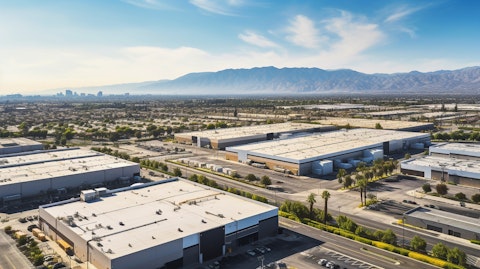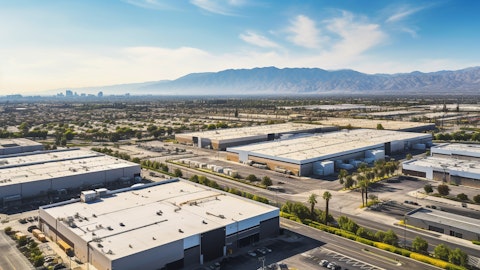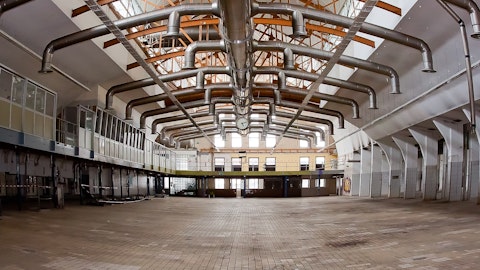Rexford Industrial Realty, Inc. (NYSE:REXR) Q1 2024 Earnings Call Transcript April 18, 2024
Rexford Industrial Realty, Inc. reports earnings inline with expectations. Reported EPS is $0.27 EPS, expectations were $0.27. Rexford Industrial Realty, Inc. isn’t one of the 30 most popular stocks among hedge funds at the end of the third quarter (see the details here).
Operator: Thank you for standing by. My name is Fabilo, and I will be your conference operator today. At this time, I would like to welcome everyone to the Rexford Industrial Realty, Inc., First Quarter 2024 Earnings Call. All lines have been placed on mute to prevent any background noise. After the speakers’ remarks, there will be a question-and-answer session. [Operator Instructions]. Thank you. I would now like to turn the conference over to David Lanzer, General Counsel. You may begin.
David Lanzer: We thank you for joining Rexford Industrial’s first quarter 2024 earnings conference call. In addition to the press release distributed yesterday after the market closed, we posted a supplemental package and investor presentation in the Investor Relations section on our website at rexfordindustrial.com. On today’s call, management’s remarks and answers to your questions may contain forward-looking statements as defined by Federal Securities Laws. Forward-looking statements address matters that are subject to risks and uncertainties that may cause actual results to differ. For more information about these risk factors, please review our 10-K and other SEC filings. Rexford Industrial assumes no obligation to update any forward-looking statements in the future.
In addition, certain financial information presented on this call represents non-GAAP financial measures. Our earnings release and supplemental package present GAAP reconciliations and an explanation of why such non-GAAP financial measures are useful to investors. Today’s conference call is hosted by Rexford Industrial’s Co-Chief Executive Officers, Michael Frankel and Howard Schwimmer, together with Chief Financial Officer, Laura Clark. They will make some prepared remarks and then we will open the call for your questions. Now, I will turn the call over to Michael.
Michael Frankel: Thank you, David. And welcome everyone to Rexford Industrial’s first quarter earnings call. I’ll begin with a few remarks, followed by Howard, who will provide market and operational detail, then Laura will provide our financial results and outlook. I’d like to begin by thanking our Rexford team for your strong results and another quarter marked by substantial value creation across the Rexford platform. On the leasing front, the team completed 3.2 million square feet of leasing activity at very favorable spreads as we continue to monetize the substantial mark-to-market for lease rates within our in-place portfolio. And notably, we extended our largest tenant, which Howard will detail shortly. On the investment front, our team completed over $1 billion of acquisitions, delivering substantial initial and longer-term accretion.
Our activity included a large off-market portfolio purchase acquired from a combination of Blackstone-affiliated entities for approximately $1 billion, comprising over 3 million square feet of high-quality warehouse products focused within Premier, Los Angeles and Orange County submarkets with tenant sizes averaging 43,000 square feet. The transaction is notable for the high quality of assets and significant levels of cash flow accretion contributed to our portfolio. In 2024 alone, the portfolio is expected to contribute an incremental $0.04 of FFO per share net of funding cost, along with an estimated 25 basis point to 50 basis point increase in operating margin. Additional growth over time will be driven by some value-add improvements, as well as the 3.9% embedded average annual rent increases within the portfolio.
The investment was also unique as it was a result of an off-market collaboration between the Rexford and Blackstone teams. We work together to curate the portfolio by selecting assets to optimize the blend of quality, return on investment and accretion to our business. The transaction is a testament to the benefits associated with working principle to principle to drive a superior outcome for both parties. The transaction is also indicative of a range of portfolios that we continue to track, which may be catalyzed from time-to-time by potential seller or market circumstances. With regard to market conditions, we are seeing some current choppiness, particularly within certain submarkets and size ranges. We expect some ongoing relative volatility within our markets through the near term, principally driven by heightened uncertainty in the interest rate environment, exacerbated by the current global geopolitical unrest.
However, despite some relative market uncertainty, we believe our infill Southern California industrial tenant base will continue to prove itself by demonstrating the nation’s strongest tenant and supply-demand fundamentals over time. Although we can’t predict how our market may perform in the future periods, so far, we are seeing a distinct and accelerating differentiation between the stronger relative performance of our infill SoCal portfolio, whether measured by net absorption, change in rents, or related metrics as compared to the relative performance of larger products sized over 200,000 square feet, primarily located in non-infill big-box markets, such as the Inland Empire. Big-box larger space is typically part of a super-regional or global logistics network where space needs are relatively fungible across locations and where demand for any single space can be highly elastic and reactive to short-term demand drivers.
In contrast, our smaller infill tenants are generally serving the nation’s largest first and last mile of distribution focused on regional consumption within the nation’s largest and most diverse regional economy, where performance through cycles has tended to be more durable. Big-box markets such as the Inland Empire are also subject to volatility, driven by substantial increases in new supply impacting occupancy through cycles as compared to our high-barrier infill market, which is subject to an ongoing scarcity of supply with a virtually incurable supply-demand imbalance over the long term. Consequently, and as we’ve observed through prior cycles, our Rexford tenant base, which averages 26,000 square feet in size and is 100% located within prime high-barrier infill SoCal markets is outperforming the big-box market and product type.
Looking forward, the growth opportunity embedded within our existing portfolio continues to be substantial. Over just the next three years, we expect cash NOI to increase by $282 million or 47%, growing to $876 million in total NOI. Importantly, this assumes today’s rents and no future acquisitions and is comprised of $94 million of incremental NOI related to repositioning and redevelopments stabilizing over the next three years, $88 million from the conversion of below-market leases to market rents, assuming today’s rents and no future market rent growth, $58 million related to acquisitions closed year-to-date and $42 million from the 3.6% embedded contractual rent steps within our current portfolio. We continue to be positioned to execute upon our expected 11% to 13% three-year average annual core FFO per share growth through 2026, which assumes no future acquisitions.
Please note, that we plan to update our long-term core FFO per share growth forecast on an annual basis at the beginning of the year. With that, I’d like to thank the Rexford team once again for your tremendous dedication and results. And I’m pleased to turn the call over to Howard.
Howard Schwimmer: Thank you, Michael, and thank you all for joining us today. Rexford began the year with strong execution across our value-creation initiatives. During the first quarter, our team completed a very strong 3.2 million square feet of leasing by executing on the increased tenant activity we experienced during the first quarter, driving 140,000 square feet of positive net absorption. Notably, we extended Tireco, our largest tenant occupying 1.1 million square feet into 2027. During the quarter, Tireco’s in-place rent increased by 4%, which was carried forward. The extension includes a 4% bump in year two and a two-month rent concession. With this lease execution, we derisked our largest near-term lease expiration, securing favorable and growing cash flow for the next three years.

Excluding the Tireco extension, leasing spreads in the quarter were 53% and 34% on a net effective and cash basis, respectively, and were in line with our expectations. Concessions increased normally from a weighted average of 1.2 months to 1.4 months sequentially. Additionally, annual embedded rent steps averaged 4% for the first quarter executed leases continuing to demonstrate our diverse tenant base’s ability to pay higher rent in future periods. Within our portfolio, with an average base size of 26,000 square feet, we observed market rent growth that was flat sequentially and approximately negative 2% year-over-year for highly functional product comparable in quality to our Rexford assets. As we have communicated, particularly with respect to select submarkets and size ridges, we expect to continue seeing some near-term fluctuations in market rents.
However, as demonstrated by the leasing activity within our portfolio and what we are seeing on the ground today, tenants are evidencing their comfort with today’s rent levels, plus 4% embedded annual rent steps. According to CBRE, vacancy in the infill markets increased 45 basis points sequentially to 3.2%. Notably, Rexford’s portfolio continues to outperform the market due to our superior quality and functionality. By way of example, Rexford’s first quarter net absorption was positive 30 basis points in contrast to the overall market’s negative 20 basis points of net absorption. In analyzing net absorption in the market, similar to prior quarters, nearly 80% of buildings that contributed to negative absorption were of lower quality, dysfunctional or obsolete, and generally non-competitive with Rexford’s portfolio.
In stark contrast to the market, Rexford’s strong new and renewal activity in the quarter drove an exceptional retention plus backfill rate of 87%. We continue to see relatively healthy tenant interest for our higher-quality product with activity on approximately 85% of our vacant spaces. Turning to Rexford’s investment activity during the quarter. We completed $1.1 billion of investments across 3.2 million square feet through off-market transactions. Subsequent to quarter-end, we closed one stabilized transaction for $27 million at a 5.5% initial unleveraged deal. Additionally, we have $275 million of pipeline acquisitions under contract or accepted offer, which are subject to customary closing conditions. The near-term pipeline investments, coupled with our year-to-date activity are projected to generate an aggregate initial yield of 5%, growing to a 5.7% unleveraged stabilized yield on total cost.
Moving to our [indiscernible] position and capital recycling program. Subsequent to quarter-end, we disposed of one property for $10 million, generating a 13% unlevered IRR. In addition, we have approximately $50 million of dispositions currently under contract or accepted offer, which are subject to customary closing conditions. Regarding our repositioning and redevelopment activity, during the quarter, we stabilized and leased approximately 40,000 square feet of repositioned property in Central San Diego, achieving an aggregate 10.8% unlevered stabilized yield on total investment. Looking forward, we have 4.6 million square feet of value-add repositioning and redevelopments in process or projected to start within the next 18 months with the remaining incremental spend of approximately $410 million, which we expect to deliver an aggregate unlevered stabilized yield on total investment of 6.2%.
Finally, I’d like to thank our Rexford team for their innovation and collaboration, driving another strong quarter of results. Now, I’m pleased to turn the call over to Laura.
Laura Clark: Thank you, Howard, and thanks to the Rexford team for your market-leading efforts that drive our strong near and long-term value creation. First quarter core FFO per share increased a strong 12% over the prior year quarter to $0.58 per share and was in line with our expectations. Same-property NOI growth was 8.5% and 5.5% on a cash and net effective basis, respectively. Leasing spreads over the trailing 12-month period of 71% on a net effective basis and 52% on a cash basis drove strong rental income growth. Turning to the balance sheet and capital markets activities, this quarter we opportunistically leveraged the balance sheet to fund accretive external, as well as internal growth opportunities, including funding incremental spend of $455 million related to the near-term pipeline of repositionings and redevelopments that are projected to generate an incremental return of approximately 15%.
At quarter end, net debt to EBITDA was 4.6 times and we anticipate that embedded internal growth alone will reduce leverage within our target 4 times to 4.5 times range in the near term. During the quarter, we executed on a number of capital markets transactions. We completed the issuance of $1.15 billion of three-year and five-year exchangeable notes at an average coupon of 4.25% and a 30% conversion premium. Let me pause here and take a few minutes to describe the mechanics of these exchangeable notes, also known as converts. Recent changes in accounting rules combined with the ability to issue converts under the Net Share Settlement method known as Instrument C have created a unique opportunity and an additional attractive capital source.
Under the Net Share Settlement method, the par value of the convert, which in this case is $1.15 billion in aggregate, is treated like a bond, whereby Rexford will pay the par value in cash at maturity. Regarding the conversion premium, if Rexford’s share price at maturity is 30% or more than the price on the date of issuance, the excess conversion value over par is settled at maturity in cash, shares or a combination of the two at Rexford’s option. This provides us with maximum flexibility at any future point in the capital market cycle. The accounting for converts has also been substantially simplified. On the income statement, the coupon, which averages 4.25% for our issuance is reflected as interest expense. In regard to the share count, only the net shares equivalent to the excess conversion value are added to the share count if and when the stock is trading above the conversion price.
Importantly, the par value of the convert has no impact to share count as it is always settled in cash. Under this structure and with the accounting rule changes, there is no immediate dilution upon issuance and any potential future dilution is mitigated through the net share settlement mechanics as well as the flexibility for Rexford to settle any excess share value above the 30% conversion premium in cash or shares in the future. Continuing with our first quarter activities and concurrent with the exchangeable note offerings, we completed a public offering of 17.1 million shares of common stock to an existing long-only investor based on the West Coast subject to forward equity sale agreements for a gross offering value of $841 million. And during the quarter, we settled the remaining forward equity sale agreements related to prior offerings for net proceeds of $290 million.
We currently maintained substantial liquidity of $2 billion comprised of $837 million of net forward equity remaining for settlement, $185 million of cash-on-hand, full availability under our $1 billion revolver, as well as expected proceeds from our capital recycling program as we harvest value through dispositions. Finally, we have no material debt maturities until 2026, inclusive of extension options. Moving to full-year guidance. As a result of the positive contribution from our first quarter investment activity, we are increasing full-year 2024 core FFO per share guidance to a range of $2.31 to $2.34, up $0.04 at the midpoint when compared to our prior guidance. Please note that our 2024 guidance range does not include acquisitions, dispositions or related balance sheet activities that have not yet closed.
In regard to our same-property guidance, our forecast assumes a range of expectations and is based upon the market dynamics we are observing today, including leasing activity and demand, current supply, and the overall health of our tenant base. To the extent circumstances our markets deteriorate beyond the current levels we are experiencing today, we will update guidance accordingly. Our 2024 cash same-property NOI guidance remains unchanged and is projected to be in the range of 7% to 8%. Net effective 2024 same-property NOI guidance has been increased to 4.25% to 5.25%, up from 4% to 5%, driven by the strong level of early renewal activity in the quarter that generates higher straight-line rental revenue. Components of our projected same-property guidance remain unchanged and includes full-year average same-property occupancy in the range of 96.5% to 97%, which is primarily driven by lease timing and average downtime.
Cash leasing spreads of approximately 50% and net effective spreads of approximately 60%, excluding the impact of the aforementioned Tireco lease extension. Note, that leasing spread guidance incorporates current market rents and leasing spreads quarter-to-quarter are impacted by the mix of leases we expect to execute. Bad debt as a percentage of revenue is expected to be in the 40 basis point to 50 basis point range and in line with pre-pandemic levels and average concessions in the 1.5 month area. Thanks again to the Rexford team for your outstanding work that differentiates our business and enables our ongoing success. We now welcome your questions. Operator?
See also 30 Least Developed Countries in Africa in 2024 and 15 Problems with Over 55 Communities.
Q&A Session
Follow Rexford Industrial Realty Inc. (NYSE:REXR)
Follow Rexford Industrial Realty Inc. (NYSE:REXR)
Receive real-time insider trading and news alerts
Operator: Thank you. The floor is now open for questions. [Operator Instructions] And your first question comes from the line of Blaine Heck with Wells Fargo. Please go-ahead.
Blaine Heck: Great. Thanks. Good morning. So one of your peers gave incrementally negative view on the timing of a rebound in activity in Southern California, but it seems as though your outlook is pretty consistent with your initial views. Michael, you gave some color earlier, which was really helpful. But can you just talk a little bit more about what might be driving that disparity, whether it’d be more conservatism in your initial view, just different size segments and/or different submarket exposure?
Michael Frankel: Hey, Blaine, thanks so much for joining us today. I appreciate the question. And it’s an important question, because I don’t think it’s just about Rexford having been maybe a little more or less conservative on a relative basis in setting expectations. I think the answer really gets more to the fundamentals of our market, and the fact that the fundamentals surrounding the infill markets where the average tenant size, for example, in our portfolio is under 30,000 square feet are very, very different than the fundamentals that often drive the larger space, 200,000 square-foot or larger space markets, which tend to be more in non-infill markets like the Inland Empire. And I think that’s really where we get to the crux of it.
And it really also gets to the fact there’s so many reasons that we design this business to focus exclusively on infill Southern California. It is a truly differentiated market with its own drivers. And as I mentioned, our tenant base in the infill markets are disproportionately serving regional consumption. It’s the largest first and last milestone of distribution and the largest regional economy in the country. And that’s really the fundamental difference. The big-box market is driven by super-regional global trade flows, global demand drivers tend to have a bigger impact on that. I think the greatest real-world case studying example probably came during the great financial crisis. And actually, we had a dramatic drop in demand globally. But if you saw the way the big-box market performed relative to the smaller tenant base like Rexford’s was dramatic.
For instance, at that time in the East Inland Empire, vacancy doubled, tripled or worse depending on the submarket and vacancy was actually relative — and occupancy was actually relatively stable within our infill markets. And that was during the worst of times, nothing like today. So I think that that’s really the key driver in differentiation in terms of performance. And then you layer on the fact that within our infill markets, Rexford, our mandate is to deliver the highest functional, best locations, highest quality product within our submarket. So even within a submarket and infill market that’s going to outperform through cycles, the big-box market within our markets, we should see a differentiated positive performance by Rexford within the submarket.
So there’s a lot to it. I think we’ve observed it through cycles, through many cycles. I think the data is pretty clear. You can go back almost 11 years and look at our disclosures when we went public. We tracked it then. So, I think it’s fairly consistent and supported by the data out there. And additionally, I think we try to take a — we do try to be conservative in how we look forward and we try not to prognosticate about what may happen in the future. And that’s why our guidance and our thoughts on the future really don’t incorporate market rent growth and things like that.
Blaine Heck: Great. Very helpful, Michael. Second question, last quarter, I believe you talked about an expectation for 40% cash rent spreads in 2024. Your spreads this quarter were 33.6% excluding Tireco. And I think you just mentioned, Laura, that the goal is now 50%, but correct me if I misheard that. So just wondering if you guys can comment on what might be giving you confidence in higher spreads in the second through fourth quarters.
Laura Clark: Yes, Blaine. Just to clarify, our cash same-property guidance for the full year is 50%, and that’s in line with our expectations that we set last quarter. Our net effective guidance for the full year is 60% and also in line with expectations that we set last quarter, excluding Tireco. So all that being said, as you know, spreads in any given quarter can vary dependent upon the leases that are rolling and the leases that are executed in that quarter. This quarter’s spreads came in right in line with our expectations for the leases that we expected to sign. As we look forward, we’re trading paper on a number of new and renewals that give us comfort that we will be able to achieve our expectations around leasing spreads for the full year.
Blaine Heck: Great. Thank you all.
Operator: Your next question comes from the line of Camille Bonnel with Bank of America.
Camille Bonnel: Good morning. I have a few questions about your investment strategy. While the cost of capital you raised allows you to transact accretively, how do you balance deploying this capital in a market when rents continue to decline and there’s risk to underwriting?
Michael Frankel: Hey, Camille, thanks so much for joining us today, and thank you for the question. So the key focus around our investment strategy is about value creation and the ability to overcome whatever cost of capital may be. In fact, we take a steady-state look at our cost of capital, which means when capital was very inexpensive, we didn’t underwrite that in our investment strategy. And the key to our investment strategy is, how we’re identifying opportunities to create value that overcome that cost-of-capital hurdle, if you will, and create value over the medium-term to long-term. And that is the greatest differentiator of our business, frankly, because even in an environment, to your question, where you may have nominal or even declining market rents, our investment strategy focused on value-creation, where we’re increasing the inherent cash flow generating capability of these assets with zero or even in some cases, declining market rent growth is truly unique and powerful.
And I think that’s where you’re going to — the more that markets stabilize or the more that you see markets overall decline, the more Rexford is going to differentiate itself because we’re going to continue to do the work, increasing the inherent cash flow generating capabilities properties through the renovations and modernizations that enable us to increase cash flow with zero or even declining market rent growth.
Camille Bonnel: Got it. And I understand at different points of your ownership, you’ll update the business plan. So if we look through to the Tireco lease extension and option you’ve created in 2027, are there levers you can pull? Or how confident are you in being able to position this asset so it performs in line or better than your initial underwriting?
Howard Schwimmer: Yes. Hi, Camille, it’s Howard. Well, first of all, the Tireco extension was done just after we increased rent 4% under the existing lease. So that option they had had a fixed increase. And so we really only gave up a 4% initial bump, which we pick up again in another year under the lease. So we’re pretty happy with that outcome. The lease also has a five-year option in it, so that we’re — the option is at fair market value. So we’re able to reset at the expiration to a market rent in 2020, which from — what we see in the marketplace, there would be substantially less deliveries in competing products even looking into expirations that could occur within the marketplace and any product that could come to market. So from our window, it looks like a much better time to be addressing that lease. And so, we’ve left the window open actually to reset and continue the performance of the asset.
Camille Bonnel: I appreciate the added color there. And you’ve built a lot of excess capital and closed the quarter with quite an elevated level of cash. So, can you shed a bit more light on how you’re thinking about the cash balance this year and what’s been assumed in guidance?
Laura Clark: Yes, Camille. Thanks for your question. In terms of our cash and liquidity as we sit today, we currently have about $2.1 billion of liquidity that does include our $1 billion revolver. On top of that, and included in the $2.1 billion is also $837 million of forward equity remaining for settlement as well as $185 million of cash on hand. So, when we look at the uses of that capital, we have about $275 million of acquisitions that are in the pipeline under accepted offer and then — or under contract. We also have about $250 million of capital to spend just this year on our repositioning and redevelopments that are in process. So that leaves us with substantial liquidity of about $600 million on top of the revolver — with the revolver.
And really, when we’re thinking about other sources of — I mean, other uses of capital, we are going to continue to be very selective in terms of investing and driving and executing on our investment strategy to find these opportunities that we can drive value creation, not just today but over — but into the future on an accretive basis.
Camille Bonnel: Thank you.
Operator: Next question comes from the line of Greg McGinniss with Scotiabank.
Greg McGinniss: Hey, good afternoon. I guess based on the data that you guys have showed us market rents held steady quarter-over-quarter, down a little bit year-over-year. But what about on net effective rents? Have you guys been seeing any increase in free rent or other concessions? And also, how are you determining market rent for the Rexford comparable portfolio?
Laura Clark: Yes, I’ll jump in here. Thanks, Greg, so much for joining us today. In terms of concessions, as you can see, I mean, our concessions this quarter were 1.4 months, excluding the Tireco lease base. Our guidance for the full year is 1.5 months. I’ll note that that’s consistent with the guidance that we — that we had last quarter. And concessions we have estimated as we did at the beginning of this year to increase from one month on average in 2023. And really that’s what we think is more consistent with the normalized market in which we’re operating in. If you look back to the pre-pandemic years 2018 and 2019, we’re assuming concessions more in line with those markets. When you look at our average concessions guidance, it includes new — and concessions on new and renewal leases.
And so when you look at our activity just this quarter, 75% of our activity was renewals that have lower concessions. Concessions on renewals this quarter were 1.2 months compared to 2.1 months on our new leases. So that’s certainly driving the average concessions of 1.5 months for the entire portfolio that we’re projecting for the full year. In terms of concessions, it certainly varies. It varies by submarket, it varies by size across the markets and certainly varies, as I mentioned, between new and renewal leases. In terms of your second question around how we determine market rents and market rent growth within our portfolio, we — our team does an incredible job every single quarter. Thank you so much to the team, by the way that since you’re on the call listening.
But they do an incredible job every quarter, bottoms-up analysis. We have over 1,600 spaces within our portfolio and we apply a market rent to each space quarterly. And that market rent is the rent that we believe that we would lease that space at today. And then we compare that rent back to the prior quarter and the market rent that we thought that we could lease the space at in the prior quarter. And that’s how we determine market rent growth for our portfolio.
Greg McGinniss: Okay. And then, I guess at the end of last year, it seemed like there was a greater openness to utilizing dispositions to fund investment activities. Did you end up taking any steps to test the market? And what were you seeing on cap rates? And did that maybe kind of push you to sticking with equity funding and the converts instead of asset sales?
Michael Frankel: Yes. Hi. Actually, we have increased activity on dispositions this year. We announced a $10 million sale with $50 million of dispositions either under contract or accepted offer. And so, we’re actually providing more transparency this year on — some increase in activity this year actually. And maybe — to your point or question, maybe reflected to the perception at least earlier this year that we’re in a more stable interest rate environment.
Howard Schwimmer: And I’ll just add to Michael’s comment, the disposition we completed for $10 million, the in-place cap rate was 4.2%.
Greg McGinniss: Okay. But it’s not — and I guess, there’s not really any expectation that dispositions will become a meaningful part of the capital structure in terms of how you’re raising funds for acquisitions or for the repositioning, redevelopment portfolio spend?
Michael Frankel: It all depends how you define meaningful. But we think it’s a very important part of our strategy, it’s a very important source of accretive capital. And so, it really depends how you would define — and, yes, that’s meaningful. And that’s why we also provide a little additional disclosure on the immediate pipeline to give folks a better sense of where the activity is.
Greg McGinniss: Okay. Thank you.
Operator: Your next question comes from the line of John Kim with BMO Capital Markets.
John Kim: Thank you. Wanted to ask you about the pricing of your off-net market transaction with Blackstone. The 4.7 initial cap rate seems a little tight just given the limited mark-to-market. It was accretive to you. I realize based on your cost of capital, but a lot of your competitors don’t have that cost of capital. So I was wondering how you came up with that pricing and where you think this would go out in the open market?
Howard Schwimmer: Yes. Hi, John. It’s Howard. Well, we’re seeing transactions in terms of the current market of — there was one that just closed that was literally a 3.7 — I think it was a 2.7 with some vacancy growing to a five in year two of with some — with obviously some lease-up risk in it. And there’s quite a few other transactions under contract that when they close, I feel, represent a little bit of cap-rate compression even to some of the cap rates we’ve seen recently. But in terms of how we curated this portfolio, it was a balance between finding high-quality assets with great functionality and location that had some growth within them. And so the initial yield of 4.7 growing to the 5.6 had the upside we were looking for.
And frankly, it’s interesting in the past, you probably heard us talk about how we conservatively underwrite. The portfolio is actually outperforming a little bit already. We’ve had some renewals and some rents that we’ve been able to put in place that are already outperforming underwriting.
John Kim: Did you get a sense that if it didn’t go to Rexford, then a similar pool of assets was gone to one of your public peers?
Howard Schwimmer: Not necessarily because we really curated the portfolio directly with Blackstone. There wasn’t a broker involved. And this was really building upon 10 years of relationship that we have with Blackstone Principles where we’ve been seeking to be able to transact with them. And it was a unique opportunity that came up. And it wasn’t a scenario where they said, hey, we’re bringing something to-market, you want an early shot out of it. It was really a collaboration here. So no, it really wasn’t something that would have just gone to somebody else. And frankly, if Blackstone had, in fact, decided to market, this particular portfolio of the marketplace right now in terms of capital coming back to the market, we think would have transacted possibly a little tighter even.
Michael Frankel: Yes. And John, just to provide an additional perspective these are assets that we are very familiar with. We’ve been underwriting them, offering on them and many of them long before Blackstone even own them. So that gave us an inherent informational advantage in terms of crafting the portfolio together with the Blackstone.




